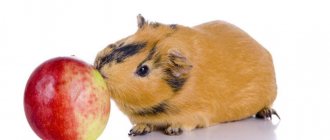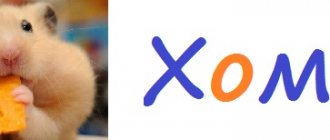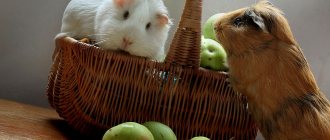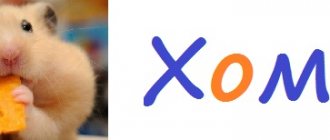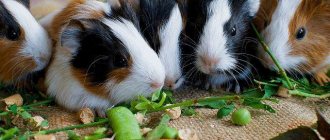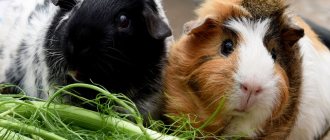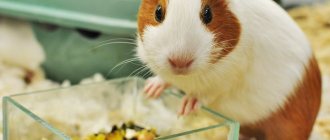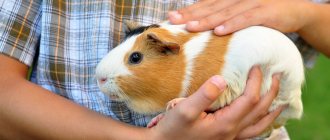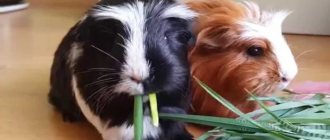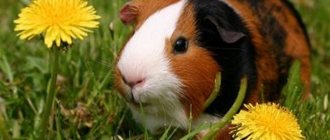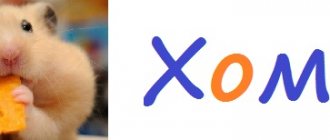- home
- Guinea pig
- Guinea pig nutrition
02/19/2019 A guinea pig is a wonderful pet. She is much more fun than a hamster; she is not so petite and demanding. To feed your guinea pig, you don’t need to go out of your way to choose an individual diet. However, sometimes you want to please your favorite animal with something tasty and unusual. You need to be sure that this tasty and unusual food will not harm the health of your fluffy. For example, can a guinea pig have a banana?
Do pigs eat bananas?
Banana is an incredibly healthy fruit. It is rich in potassium, nutritious fats. Eating one fruit will give you a lot of strength and energy.
Owners of guinea pigs often notice that the animal eats everything that gets into its cage. If you put a piece in, he will eat that too. But won't it cause harm? Can I feed my guinea pig bananas?
Along with the benefits from the banana, the animal will also receive considerable harm. Fruits contain a lot of sugar, which has an extremely negative effect on the overall health of any living organism. Thus, an elementary conclusion suggests itself - you can feed your pig bananas only in moderation; this is strictly prohibited on an ongoing basis.
Can guinea pigs eat banana chips?
Banana chips are dried banana pieces that many people eat as a snack. During the process of drying the fruit, the nutritional value of the banana changes. Banana chips contain much more sugar than a fresh banana, which means you should not feed banana chips to your pet. High levels of natural sugar are harmful to your guinea pig's teeth and cause stomach upset.
What are the benefits of bananas for a guinea pig?
The nutritional value of the fruit is what decides whether it is healthy for your guinea pig to eat. Nutritional value of 100 g of raw fresh bananas:
- Energy - 89 kcal
- Proteins - 1.09 g
- Carbohydrates - 22.84 g (12.23 g sugar)
- Fat - 0.33 g
- Vitamins – B1, B2, B3, B5, B6, B9 and C
- Minerals - iron, magnesium, manganese, phosphorus, potassium and zinc.
Although banana is quite high in natural sugar, this fruit does have some benefits for your guinea pig's diet. It offers a range of vitamins and minerals that are important for your guinea pig's health and is especially rich in vitamin B6.
What are the benefits of banana chips for your guinea pig?
The nutritional value of banana chips is different from the nutritional value of raw bananas. Nutritional value of 100 g banana chips:
- Energy - 520 kcal
- Proteins - 2.3 g
- Carbohydrates - 58.4 g (35.34 g sugar)
- Fat - 33.6 g
- Vitamins – A, B1, B2, B3, B6, B9, C, E and K
- Minerals - calcium, copper, iron, magnesium, phosphorus, potassium and zinc.
Although banana chips may contain a good range of vitamins and minerals, the natural sugar content is too high for guinea pigs. Dried banana chips are also high in fat.
What about banana peels?
Many owners believe that they should give their guinea pig a banana right away along with the skin. They have their own arguments on this matter. Still, this is a plant product, and its peel should not be dangerous to the health of your furry pet. Moreover, it must contain important nutrients, such as the spicy leaves.
Of course, if you don't separate the banana peel, your pet will eat it. But it will not produce any positive effect. Why?
Unfortunately, people do not have the opportunity to get them fresh. A lot of time passes from the time they are collected and transported to the stores. All this time they must maintain their presentation, otherwise everything will be in vain - they will “disappear” and they will not be bought. Therefore, fruits are covered with all sorts of harmful chemicals. This chemical is “absorbed” into the banana peel.
Citrus fruits, pears, apples in the diet of guinea pigs
The basis of the daily menu for guinea pigs is cereals and fresh plant food. However, not all types of vegetables, fruits or berries are beneficial for these rodents.
Table 1. Forbidden foods
| Products | Herbs | Berries |
| Rhubarb, sorrel, chicken eggs, garlic, onions and green onions, sugar, milk, sweet cookies. | Leaves and stems of celandine, mint, fern, thyme, snowdrop, basil, foxglove, aloe, honeysuckle. | Plums, peaches, apricots, cherries. |
Interesting! Veterinarians advise adding spinach leaves, beet and radish tops, parsley, and dandelion leaves to the menu of pet rodents.
In order for animals to receive enough vitamins and microelements, they must eat at least 120 g of fresh fiber daily. Before giving vegetables or fruits to your pet, they must:
- Wash thoroughly.
- Cut into pieces (small so that the animal can eat them completely).
Important! Spoiled or rotting products should not be used to feed domestic rodents.
Citrus
The diet of guinea pigs includes 3 parts:
- basic (grain mixtures, most often made from oats);
- additional (treats);
- vitamin and mineral (supplements).
The body of furry pets does not know how to reproduce vitamin C on its own; it is “extracted” from food.
Read more about “How to properly feed a guinea pig.”
Zoological experts strongly advise against feeding guinea pigs citrus products regularly.
Important! Before giving fruit to animals, the fruits are freed from seeds and peel. The zest is strictly contraindicated for guinea pigs.
Some rodents are ready to treat themselves to juicy oranges or tangerines at least every day, but this should not be allowed. A healthy animal is allowed to eat a piece of orange, tangerine or grapefruit 1-2 times in 7-10 days.
Important! Citrus fruits should not be given to young pigs with an immature digestive system and to females during pregnancy or lactation.
Uncontrolled consumption of citrus fruits can cause serious health problems in animals. The most common of them are:
- hypervitaminosis;
- skin irritations;
- allergic rashes;
- change in the composition of urine.
If you decide to pamper your guinea pig with tangerine, you can give it only 1 slice. If there are several individuals in one cage, it is necessary to carefully monitor that the more nimble pets do not eat someone else’s food. 1–2 hours after the meal, the remaining food is removed.
Interesting! The animals should be observed after feeding citrus fruits. If digestive problems occur, the treat should be excluded from the diet.
Pears
The leaves and young branches of pear trees are very useful for the health of rodents. The fruits themselves can be given to animals only occasionally, as a treat.
If you offer your guinea pig a pear, you need to give it water at the same time. High levels of sucrose in juicy fruits often provoke the development of diarrhea in rodents. To neutralize the adverse effects, you should reduce the concentration of sugar in the body of your furry pets and dilute the treat with water.
For guinea pigs, it is better to choose firm varieties of pears. The average norm per day is approximately 40–45 g. These fruits can be fed to rodents along with the peel. However, it is better to remove the seeds in advance to avoid complications with the digestive system.
Apples
These fruits are simply necessary for guinea pigs to maintain health and daily activity. Most animals prefer sweet varieties. The most useful fruits for rodents are Antonovka, Titovka, and Semerenko.
Fruits have a perfectly balanced ratio of fructose (80%) and sucrose (18%). In addition, they contain pectin, fiber, B vitamins, and beneficial minerals.
Interesting! If the apples are dried, they are soaked and boiled before feeding.
Pigs enjoy eating both fresh and dried apples. The fruits are first peeled and cut into small slices. The maximum amount of treats at one time for each animal is no more than 3 pieces.
Important! Apple seeds must be removed in advance. They contain a substance that, when exposed to gastric juice, is converted into hydrocyanic acid, a high concentration of which can kill the animal.
Feeding rules
For a guinea pig, banana is primarily a sweetness. You can’t go overboard with sweets, no matter what animal you’re talking about. Before three months you should not give fruit, but after three months you need to follow the dosage.
You can enjoy treats every day, but the piece should not be more than one-fourth of the whole fruit. It should be introduced into the diet evenly, starting with one sixth or less.
Bananas are soft, so they are suitable as a treat for both young animals and “elderly” individuals. It doesn’t require much strength from your pet to chew a piece, and it will saturate the body with useful substances one way or another.
How to give correctly
Moderation is good in everything. In general, feeding a guinea pig, as a rule, involves 2-3 meals a day, where breakfast is “juicy food,” greens and hay. It is for breakfast that the bulk (but not the entire daily requirement!) of vegetables and fruits is served. You should be careful when introducing fruit into your diet, not only when it comes to exotic bananas, tangerines, and so on. Apples and pears, so accessible and understandable in our latitudes, are the most common cause of stomach upset in rodents. Most often, it is precisely because of the carelessness of the owners, who are focused on their own perception of these food products.
There are several simple rules for introducing new foods into a rodent’s diet:
- Before introducing a product into your diet on an ongoing basis, test it. Give your pet a banana slice 1–1.5 cm thick. If everything is fine within 24 hours after the experiment, you can introduce the product.
- You should not suddenly introduce/remove any product from your diet. Innovate smoothly.
- Be sure to maintain good hygiene: throw away uneaten food and thoroughly wash food and bowls before serving.
- Fruit is a rodent nutritional supplement. It is worth introducing such variety on average 2–4 times a week.
- Remember, the daily intake of “succulent food” is 20–30% of the animal’s body weight. However, this amount should not consist of one product and should not be given all at once.
Did you know? Guinea pigs are social animals and are much happier when they live in pairs or in groups.
As you know, most diseases appear precisely because of negligence in such simple matters as hygiene or an adequate amount of food per day.
Possible problems
- Binge eating.
This occurs due to non-compliance with the dosage and is fraught with serious consequences. It is important to understand that animals, despite their instinctive thinking, are also capable of eating too much or too little.
If you consume bananas excessively, the animal will not be able to go to the toilet.
- Diarrhea and poisoning.
You always need to make sure that the product is of high quality and that the skin is completely peeled off. Otherwise, trouble in the digestive system is inevitable.
Banana peel
Whether guinea pigs can peel bananas is another matter entirely. Some people do this, believing that if the animal eats, then it is allowed. But this is a mistake; if in the wild this can still be justified, then in captivity it is not. Before the fruit reaches you, it is treated several times with different chemicals for long-term storage. Much less of it gets into the banana itself, and many times more remains on the peel.
Chemicals are also used during cultivation. Therefore, in order not to harm your pet, never give banana peels to guinea pigs. It’s better to give a piece of the finished product, she won’t eat much. Remember that we are responsible for those we have tamed.
Dairy
Can guinea pigs have milk?
Giving milk to guinea pigs is not recommended. The enzyme that is responsible for the breakdown of milk sugar (lactose) is found in insufficient quantities in the body of animals. If your pig drinks milk, the lactose will cause diarrhea and bloating. More serious diseases may develop in the future, so it is better to show your pet to a doctor.
Females can and even need to be given milk during lactation. You can soak crackers in milk and offer them to your pig.
The ban also applies to other dairy products: cottage cheese, cheese, yogurt and others.
How much and how often can you feed your guinea pig bananas?
Fresh, raw banana pulp can be eaten in moderation. For a guinea pig, one centimeter piece per week is enough. You should not give your pet more than this amount, as the natural sugar contained in bananas can upset your guinea pig's stomach and damage its teeth. They may also occasionally eat banana peels if you cut them into pieces first to reduce the risk of choking. Guinea pigs should not be fed banana chips as the natural sugar content of this dried fruit is too high for guinea pigs.
And now about the cheese itself
Cheese has beneficial properties. What does this product consist of? The main raw materials for its production are milk, starter culture, and rennet. According to the technology, the end result is a fairly fatty product.
But fatty foods are contraindicated for guinea pigs, since the animal’s gastrointestinal tract is completely unsuited to digesting such “dishes” and will not be able to cope with them.
Like all herbivorous animals, pigs do not have the enzymes “responsible” for the digestion of animal proteins and fats, therefore all products of this series are not only not recommended, but also prohibited.
This is a huge burden on the liver, where they are neutralized, and if your pet is treated to such food, this organ may fail at one moment. Likewise, the animal can die from developing vascular atherosclerosis and even a heart attack or stroke. And the owner will have no idea that poor nutrition is to blame.
The fat content of cheese is the number one negative indicator, but there are others, in particular:
- preservatives;
- spices;
- various flavoring additives;
- sugar;
- salt.
Here, as they say, comments are unnecessary.
Do pets eat fruit?
Every owner of such a pet has noticed that the animal eats everything that is offered to it. And even if he eats a banana with pleasure, can he have this fruit? Since banana fruits are considered sources of potassium, the animal will receive considerable benefits from them .
But this does not mean that the rodent needs to be fed such a delicacy. After all, bananas also contain a lot of sugar, which negatively affects the condition of the guinea pig’s body. It is easy to conclude that such a product can be given to a pet, but in limited quantities .
Criterias of choice
If you still want to treat your little rodent with a treat, you need to understand the right choice of fruit.
The banana should not contain any green coloring, otherwise you will feed your pet solid starch. There should be small black spots on it, which means the fruit is ripe. You can also determine ripeness by smell. A yellow banana will have no odor, but the aroma of the spotted yellowish fruit will not let you pass by.
Remember, the main diet of rats: cereals, grains, dairy products and lean meat. Banana is a fruit that provides vitamins to animals. Protein is necessary for full functioning and health. It supports immunity and develops bones and muscle tissue.
Knowing all the subtleties in choosing and consuming bananas, you can not only not harm the little rodent’s body, but also please him with a pleasant treat from which he will receive the necessary vitamins.
What other fruits and berries can you give?
Guinea pigs love fruits; there are no clear recommendations or contraindications. When choosing, you should consider two points:
- Vitamin C is essential for guinea pigs because their body does not produce it. Without its consumption, the animal can be completely paralyzed.
- Some foods are allergenic (citrus fruits), which is why you should first try giving a small dose and only if your pet reacts positively to it, continue feeding it.
Otherwise, these animals are very omnivorous, especially in matters of fruits and berries.
You can and even need to please your pet with bananas. And if you approach the issue responsibly and sensibly, then feeding will bring a lot of pleasure to the pig. And as you know, a happy pet makes its owners happy too.
Other products
Can guinea pigs eat bread? It's better not to give.
Fresh yeast bread takes a long time to digest and causes fermentation in the animal’s stomach. White bread causes bloating. Your pet can eat stale bread, but not often. Dried bread with seeds, sesame seeds and raisins can sometimes be offered to your pet as a treat.
Can guinea pigs eat nuts and seeds?
Nuts and seeds are among the allowed foods, but can cause obesity if their consumption is not limited. It is better to offer your pet almonds, walnuts or hazelnuts.
The seeds contain many components useful for the animal: fatty acids, calcium, sodium, phosphorus, proteins and vitamins. It is better to give peeled seeds and make sure that they are no more than 15% of the total feed.
Bottle with drinker
Such an accessory will come in handy during street walks. It does not take up much space, weighs little and does not hinder movement. But you can offer the dog to quench his thirst at any time, and not wait until he starts drinking from a dirty puddle or lake overgrown with mud.
The device consists of a water container and a bowl equipped with a dispenser button. It allows you to release as much liquid from the bottle as the animal needs to quench its thirst. Sold in two volume options - 350 and 550 milliliters.
Price – 475 – 584 rub.
Another model of the same device has a folding shape, which makes it easier to carry. The transformer connects the bowl and the bottle, securely fixing them in such a compact state. The durable polymer material has good shockproof properties and can even resist dog teeth. True, this struggle will not be long and - if the owner is careless - then all the liquid will end up on the ground.
Volume 250 ml.
Cost – 133 – 148 rubles.
I like1I don't like
